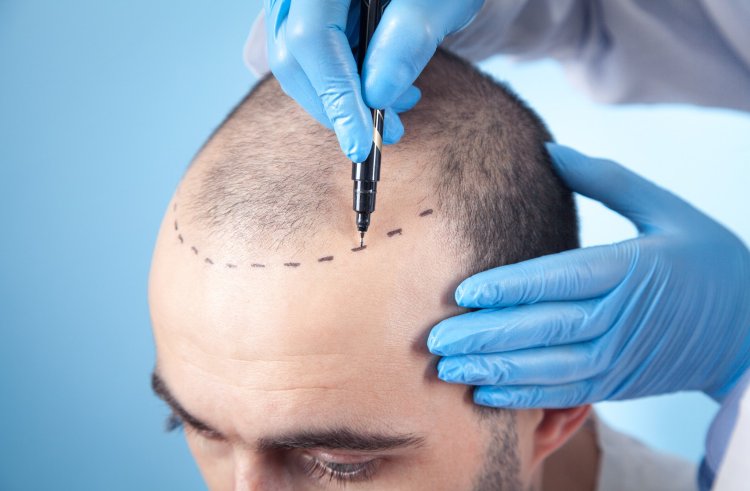Unlocking the Mysteries of Hair Transplants: From Follicle to Future
Hair transplants have evolved from a niche procedure into a mainstream solution for hair loss, thanks to advancements in medical technology and techniques. As this once-mysterious procedure gains popularity, understanding the science behind it can help set realistic expectations and ensure a successful outcome. This comprehensive guide delves into the intricate world of hair transplants, explaining the underlying science, what to expect before, during, and after the procedure, and how modern innovations are shaping the future of hair restoration.

The Biology of Hair Growth: A Foundation for Understanding
To appreciate the complexity of hair transplants, it’s crucial to understand how hair grows and what factors contribute to hair loss. Hair growth is a cyclical process involving three main phases: anagen (growth), catagen (transitional), and telogen (resting).
- Anagen Phase (Growth): This is the active growth phase where the hair follicle produces new cells, leading to the elongation of the hair shaft. Hair remains in this phase for several years, depending on genetics and overall health.
- Catagen Phase (Transitional): This short phase lasts a few weeks, during which hair growth slows, and the follicle shrinks.
- Telogen Phase (Resting): Hair enters a resting phase that lasts for several months. At the end of this phase, the hair falls out, and a new cycle begins.
Understanding these phases helps to grasp why hair transplants take time to show results. Transplanted hairs must first establish themselves in the new location, which involves a temporary shedding phase before new growth begins.
The Art and Science of Hair Transplants
Hair transplantation is a surgical technique that involves moving hair follicles from a donor site (usually the back or sides of the scalp) to areas affected by hair loss. This procedure is both an art and a science, combining technical skills with an aesthetic understanding of natural hair patterns.
Follicular Unit Transplantation (FUT)
FUT, also known as strip harvesting, is one of the traditional methods of hair transplantation. During this procedure, a strip of scalp skin containing hair follicles is removed from the donor area. The strip is then divided into individual follicular units under a microscope. These units are subsequently implanted into the thinning or balding areas of the scalp.
Pros of FUT:
- Proven long-term results.
- Suitable for patients requiring a large number of grafts.
Cons of FUT:
- Linear scar at the donor site.
- Longer recovery time compared to FUE.
Follicular Unit Extraction (FUE)
FUE is a more modern technique that involves extracting individual hair follicles directly from the donor area using a specialized punch tool. These follicles are then implanted into the recipient area.
Pros of FUE:
- Minimally invasive with no linear scar.
- Shorter recovery time.
Cons of FUE:
- Can be more time-consuming and expensive.
- May not be suitable for patients needing a large number of grafts.
Pre-Procedure Preparation: What to Expect
Before undergoing a hair transplant, several steps and considerations will ensure the procedure’s success.
Initial Consultation
Your journey starts with a consultation where a hair restoration specialist will evaluate your hair loss pattern, discuss your goals, and recommend the most suitable method. This consultation often includes a detailed medical history, assessment of donor and recipient areas, and an explanation of the procedure, including potential risks and benefits.
Pre-Procedure Instructions
To prepare for the procedure, you may need to follow specific guidelines:
- Avoid Blood Thinners: Medications like aspirin can increase bleeding risks, so you may need to stop taking them a week before the surgery.
- Shampoo and Clean: Keep your scalp clean and avoid using products that might irritate the skin.
- Avoid Alcohol and Smoking: Both can impair healing, so it’s best to abstain from these substances leading up to your surgery.
Pre-Procedure Testing
Some clinics may require blood tests to check for any underlying health issues and ensure you are a suitable candidate for the surgery.
The Day of the Procedure: What to Expect
On the day of your hair transplant, you’ll be guided through a series of steps to ensure the procedure goes smoothly.
Anesthesia
Hair transplant procedures are typically performed under local anesthesia. This means you will be awake during the surgery but will not feel any pain. The anesthesia will numb both the donor and recipient areas.
Procedure Time
Depending on the technique used and the number of grafts required, the procedure can take anywhere from 4 to 8 hours. For larger sessions, it might be spread over two days.
Post-Procedure Care
After the procedure, you will receive specific care instructions, which may include:
- Avoiding Physical Activity: For a few days, to reduce swelling and ensure proper healing.
- Taking Prescribed Medications: To manage pain and prevent infection.
- Avoiding Direct Sunlight: To protect your scalp from potential damage.
Recovery and Results: What to Expect
The recovery period after a hair transplant is crucial for achieving optimal results. Here’s what you can expect:
Immediate Aftercare
- Swelling and Discomfort: Some swelling and discomfort are normal but should subside within a few days. Over-the-counter pain medications may be recommended.
- Scabbing and Shedding: Small scabs will form in the recipient area, and you may notice some hair shedding. This is a normal part of the process, known as “shock loss,” where transplanted hairs fall out before new growth begins.
Long-Term Growth
- Initial Results: New hair growth typically starts within 3 to 4 months after the procedure. Full results are generally visible within 9 to 12 months.
- Maintenance: To maintain results, you might need ongoing treatments or medications to prevent further hair loss.
Advancements and Innovations in Hair Transplant Technology
As with any medical field, hair restoration has seen significant advancements over the years. These innovations not only improve the efficacy of hair transplants but also enhance the overall patient experience.
Robotic Hair Transplants
Robotic systems, such as the ARTAS® Robotic Hair Restoration System, represent a significant leap forward in hair transplantation. These systems use advanced algorithms and artificial intelligence to assist in the extraction and implantation of hair follicles.
Benefits of Robotic Systems:
- Precision: Enhanced accuracy in follicle extraction and placement.
- Consistency: Uniform results due to reduced human error.
- Minimized Invasiveness: Improved technique reduces scarring and recovery time.
Platelet-Rich Plasma (PRP) Therapy
PRP therapy is an adjunct treatment often used in conjunction with hair transplants. It involves extracting a sample of your blood, processing it to concentrate the platelets, and then injecting this concentrated plasma into the scalp.
How PRP Enhances Results:
- Stimulates Growth: Platelets contain growth factors that promote hair follicle regeneration.
- Improves Healing: Accelerates healing in the recipient area.
Stem Cell Therapy
Stem cell therapy is an emerging field in hair restoration that focuses on regenerating hair follicles. Researchers are exploring ways to use stem cells to stimulate dormant hair follicles and enhance hair growth.
Potential Benefits:
- Regrowth of Non-Transplanted Areas: Could potentially regenerate hair in areas not treated by traditional transplantation.
- Enhanced Healing: Promises to accelerate healing and improve overall outcomes.
Understanding Risks and Complications
Despite the advancements in hair transplant technology, it is essential to be aware of potential risks and complications associated with the procedure. While rare, these issues can impact the success of the surgery and your overall satisfaction.
Common Risks
- Infection: Though rare, infections can occur in the donor or recipient areas. Following post-operative care instructions and using prescribed antibiotics can mitigate this risk.
- Bleeding: Minor bleeding at the donor or recipient sites is possible but generally controllable.
- Scarring: While modern techniques reduce scarring, some residual marks may remain, particularly with FUT.
Complications
- Unnatural Hair Growth: Improper placement of follicles can lead to hair growth that appears unnatural. This risk is minimized by choosing an experienced surgeon.
- Persistent Shedding: Some patients experience prolonged shedding of transplanted hairs, which may be distressing but usually resolves with time.
Choosing the Right Hair Transplant Surgeon
Selecting a qualified and experienced hair transplant surgeon is critical to achieving the best results. Here are some tips to help you make an informed choice:
Credentials and Experience
- Board Certification: Ensure the surgeon is board-certified in dermatology or plastic surgery.
- Experience: Look for a surgeon with extensive experience in hair transplantation, particularly with the technique you are considering (FUT or FUE).
Before and After Photos
Review before and after photos of previous patients to gauge the surgeon’s ability to achieve natural-looking results.
Patient Reviews
Read reviews and testimonials from past patients to understand their experiences and outcomes.
Long-Term Care and Maintenance
Achieving the best results from a hair transplant requires ongoing care and maintenance. Here are some practices to consider:
Regular Follow-Ups
Schedule regular follow-up appointments with your hair transplant specialist to monitor progress and address any concerns.
Hair Care Routine
Adopt a hair care routine that includes:
- Gentle Shampoos: Use mild shampoos that do not irritate the scalp.
- Avoiding Heat and Chemicals: Minimize the use of heat styling tools and harsh chemicals that can damage the hair.
Medications
Your specialist may recommend medications to prevent further hair loss and support the health of your transplanted hair. This could include medications like minoxidil or finasteride.
Lifestyle Factors
Maintain a healthy lifestyle to support hair growth, including:
- Balanced Diet: Eat a diet rich in vitamins and minerals essential for hair health.
- Stress Management: Practice stress-reducing techniques such as meditation or exercise.
Looking Ahead: The Future of Hair Transplants
The future of hair transplants is promising, with ongoing research and development focused on improving techniques and outcomes. Innovations in genetics, regenerative medicine, and biotechnology hold the potential to revolutionize hair restoration.
Genetic Research
Understanding the genetic basis of hair loss could lead to more personalized treatments and targeted therapies that address the root causes of hair thinning and loss.
Biotechnology and Tissue Engineering
Advances in biotechnology and tissue engineering may enable the development of new hair follicles from stem cells, offering new possibilities for hair restoration.
In summary, hair transplants have come a long way from their early days, thanks to advancements in techniques and technology. Understanding the science behind the procedure, preparing adequately, and following post-operative care guidelines can significantly impact the success of your hair restoration journey. As innovations continue to shape the future of hair transplants, patients can look forward to even more effective and natural solutions for hair loss.
Disclaimer: The information provided in this article is for educational purposes only and should not be considered medical advice. If you have any health concerns or are experiencing symptoms, it is important to consult with a healthcare professional, such as a doctor or clinic, for proper diagnosis and treatment. Always seek the advice of your doctor or other qualified health provider with any questions you may have regarding a medical condition. Do not disregard professional medical advice or delay in seeking it because of something you have read in this article.
What's Your Reaction?





















